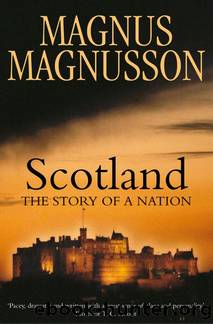Scotland by Magnus Magnusson

Author:Magnus Magnusson [Magnus Magnusson]
Language: eng
Format: epub
ISBN: 9780007374113
Publisher: HarperCollins Publishers
Published: 2012-09-14T16:00:00+00:00
Civil war in Scotland (1570–73)
The downfall of the regent came, brutally, after only a year. On 23 January 1570, as the Earl of Moray was riding through the main street of Linlithgow, he was shot in the stomach by a Hamilton laird (James Hamilton of Bothwellhaugh) who had hidden himself behind a line of washing at an upstairs window. The house belonged to John Hamilton, the Catholic Archbishop of St Andrews, a kinsman of the assassin and a Marian. The archbishop took refuge in Dumbarton Castle after the assassination, but was eventually to pay with his life; when the castle was taken in April 1571 he was hanged in his episcopal vestments at Stirling after a summary trial.
For six months after Moray’s assassination Scotland was without a regent until, on 12 July 1570, the Earl of Lennox, father of the murdered Darnley, was appointed to the post on the recommendation of Queen Elizabeth. During the interregnum support had been growing for the Queen’s Party. The Queen’s Men set up a rival parliament, and at a session in Linlithgow on 12 July Mary’s supporters declared that they would never acknowledge Lennox as regent – they knew all too well how much he hated his daughter-in-law. Kirkcaldy of Grange openly declared for Queen Mary. The Earl of Huntly assembled forces and marched south, but was defeated by Lennox at Brechin. Gradually Lennox began to stamp his authority on Scotland by force of arms. In February 1571 he defeated a Hamilton uprising at Paisley; and on 2 April one of his lieutenants succeeded in capturing the formidable stronghold of Dumbarton after scaling the sheer face of the castle-rock in the dead of night.
In May, Lennox turned his attention to Edinburgh, where Kirkcaldy of Grange held the castle against him. Lennox fortified an area of the Canongate and held a parliament within it. It was dubbed the ‘creeping parliament’ because it adjourned after less than an hour under heavy bombardment from the guns of Edinburgh Castle; but it had made its point.
Edinburgh was now a divided city. It had two town councils and two kirk sessions. John Knox prudently withdrew to St Andrews. The King’s Men set up a complete government-in-exile in Leith, which was besieged by the Queen’s Men for fifteen increasingly bitter months. The rival parliaments spent much time sentencing their opponents to death and forfeiting their lands. Violence became endemic: prisoners were executed without mercy, houses destroyed at random.
At the end of August 1571 the King’s Party held a parliament in Stirling. It was graced by the presence of the five-year-old King James, wearing a makeshift crown because the royal regalia were still held in Edinburgh Castle.1 Kirkcaldy of Grange now attempted an audacious coup d’état: on 3 September he sent a raiding party of four hundred commandos to Stirling to seize the King’s Lords and, if possible, the king himself. They entered Stirling by night and succeeded in capturing many of the nobles, including the regent. The Earl of Mar,
Download
This site does not store any files on its server. We only index and link to content provided by other sites. Please contact the content providers to delete copyright contents if any and email us, we'll remove relevant links or contents immediately.
| Africa | Americas |
| Arctic & Antarctica | Asia |
| Australia & Oceania | Europe |
| Middle East | Russia |
| United States | World |
| Ancient Civilizations | Military |
| Historical Study & Educational Resources |
Ivan Lendl- the Man Who Made Murray by Mark Hodgkinson(589)
Stone of Destiny by Ian Hamilton(468)
Scotland by Magnus Linklater(451)
How the Scots invented the Modern World: the true story of how western Europe's poorest nation created our world & everything in it by Arthur Herman(416)
Megrahi by John Ashton(395)
The Rise and Fall of the City of Money by Ray Perman(386)
Treachery and Retribution by Andrew Rawson(355)
Haud Ma Chips, Ah've Drapped the Wean! Glesca Grannies Sayings, Patter and Advice by Allan Morrison(320)
Scotland by Magnus Magnusson(318)
The Inner Life of Empires by Emma Rothschild(308)
The Reivers by Alistair Moffat(308)
Calum's Road (N) by Roger Hutchinson(247)
Jacobites by Jacqueline Riding(242)
William Wallace and Robert the Bruce: The Lives of Scotland’s Most Famous Military Heroes by Charles River Editors(234)
